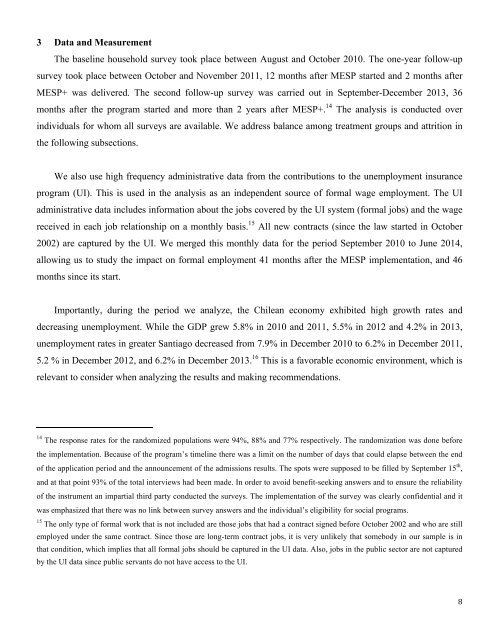DOCUMENTO
n?u=RePEc:ioe:doctra:461&r=lam
n?u=RePEc:ioe:doctra:461&r=lam
Create successful ePaper yourself
Turn your PDF publications into a flip-book with our unique Google optimized e-Paper software.
3 Data and Measurement<br />
The baseline household survey took place between August and October 2010. The one-year follow-up<br />
survey took place between October and November 2011, 12 months after MESP started and 2 months after<br />
MESP+ was delivered. The second follow-up survey was carried out in September-December 2013, 36<br />
months after the program started and more than 2 years after MESP+. 14 The analysis is conducted over<br />
individuals for whom all surveys are available. We address balance among treatment groups and attrition in<br />
the following subsections.<br />
We also use high frequency administrative data from the contributions to the unemployment insurance<br />
program (UI). This is used in the analysis as an independent source of formal wage employment. The UI<br />
administrative data includes information about the jobs covered by the UI system (formal jobs) and the wage<br />
received in each job relationship on a monthly basis. 15 All new contracts (since the law started in October<br />
2002) are captured by the UI. We merged this monthly data for the period September 2010 to June 2014,<br />
allowing us to study the impact on formal employment 41 months after the MESP implementation, and 46<br />
months since its start.<br />
Importantly, during the period we analyze, the Chilean economy exhibited high growth rates and<br />
decreasing unemployment. While the GDP grew 5.8% in 2010 and 2011, 5.5% in 2012 and 4.2% in 2013,<br />
unemployment rates in greater Santiago decreased from 7.9% in December 2010 to 6.2% in December 2011,<br />
5.2 % in December 2012, and 6.2% in December 2013. 16 This is a favorable economic environment, which is<br />
relevant to consider when analyzing the results and making recommendations.<br />
14 The response rates for the randomized populations were 94%, 88% and 77% respectively. The randomization was done before<br />
the implementation. Because of the program’s timeline there was a limit on the number of days that could elapse between the end<br />
of the application period and the announcement of the admissions results. The spots were supposed to be filled by September 15 th ,<br />
and at that point 93% of the total interviews had been made. In order to avoid benefit-seeking answers and to ensure the reliability<br />
of the instrument an impartial third party conducted the surveys. The implementation of the survey was clearly confidential and it<br />
was emphasized that there was no link between survey answers and the individual’s eligibility for social programs.<br />
15 The only type of formal work that is not included are those jobs that had a contract signed before October 2002 and who are still<br />
employed under the same contract. Since those are long-term contract jobs, it is very unlikely that somebody in our sample is in<br />
that condition, which implies that all formal jobs should be captured in the UI data. Also, jobs in the public sector are not captured<br />
by the UI data since public servants do not have access to the UI.<br />
8



